Introduction
Navigating the complexities of the immigration visa bulletin can feel overwhelming, especially for healthcare workers eager to build their careers in the U.S. Have you ever felt lost in the immigration process? With the growing demand for medical professionals, grasping this essential tool is crucial for timely visa applications and securing residency status. As immigration policies shift, the stakes are high - how can healthcare workers effectively manage their immigration journeys and steer clear of common pitfalls? This article dives into ten key insights designed to empower medical professionals, helping them navigate the immigration visa bulletin with confidence and clarity. Remember, you’re not alone in this fight.
Vasquez Law Firm: Expert Guidance on Navigating the Immigration Visa Bulletin
Vasquez Law Firm stands out in immigration law, offering specialized guidance on the immigration visa bulletin, a crucial tool for medical professionals navigating their immigration journeys. With over 30 years of experience, we’ve successfully assisted thousands, ensuring they understand their rights and options in a complex legal landscape.
Have you ever felt lost in the immigration process? The immigration visa bulletin is vital in determining visa availability, particularly for medical professionals aiming to immigrate to the U.S.; for example, nurses typically fall under the EB-3 category, which accounts for 28.6% of the global limit, translating to about 40,040 immigrants each year. This is particularly significant given the projected need for an additional 2.9 million nurses by 2030 to meet healthcare demands.
Our firm’s track record of successful cases for medical professionals underscores our commitment to providing tailored legal solutions. As immigration policies evolve, including recent bipartisan efforts to expand permit options for medical professionals, Vasquez Law Firm remains a steadfast ally for those navigating these changes.
It’s important to know you have rights, even when the system feels overwhelming. Our dedication to client support ensures that medical workers receive the information they need to make informed decisions about their residency status. We’re here to fight for your family-your future matters to us. Yo Peleo - We Fight.

Understanding Priority Dates: Key to Your Immigration Journey
Priority timestamps mark the moment your immigration request hits USCIS, determining your spot in the immigration queue. For medical professionals, grasping the significance of your priority timeline is vital; it dictates when you can kick off your green card application. As of November 2025, processing times for medical visas can vary widely, with many applicants facing waits of two to three years or even longer before landing an interview. Keeping an eye on the immigration visa bulletin is crucial for tracking your priority's progress and determining when to take the next steps in your immigration journey.
The demand for healthcare workers, especially nurses, is soaring. Over 300,000 foreign-educated nurses are actively contributing to patient care in the U.S. In fact, international nurses make up about 15 percent of the U.S. RN workforce, and the number of hospitals hiring foreign-educated staff has doubled since 2010. This growing reliance on global talent underscores the importance of acting swiftly regarding your priority timelines.
Real-world examples highlight the urgency of staying on top of these timelines. Nurses who have submitted I-140 petitions may be able to reclaim their old priority timelines, allowing them to bypass current backlogs. This strategic move can significantly speed up their green card process, emphasizing the need for proactive management of visa timelines.
Experts stress that being aware of key timelines is essential for healthcare professionals navigating the relocation landscape. As Vasco Lopes da Silva, EVP of Global Strategic Talent for Conexus MedStaff, notes, "Navigating U.S. entry processes can feel overwhelming, especially in today’s unpredictable landscape." Therefore, keeping your documentation organized and being ready to act when your priority date becomes current is crucial for a successful immigration journey.
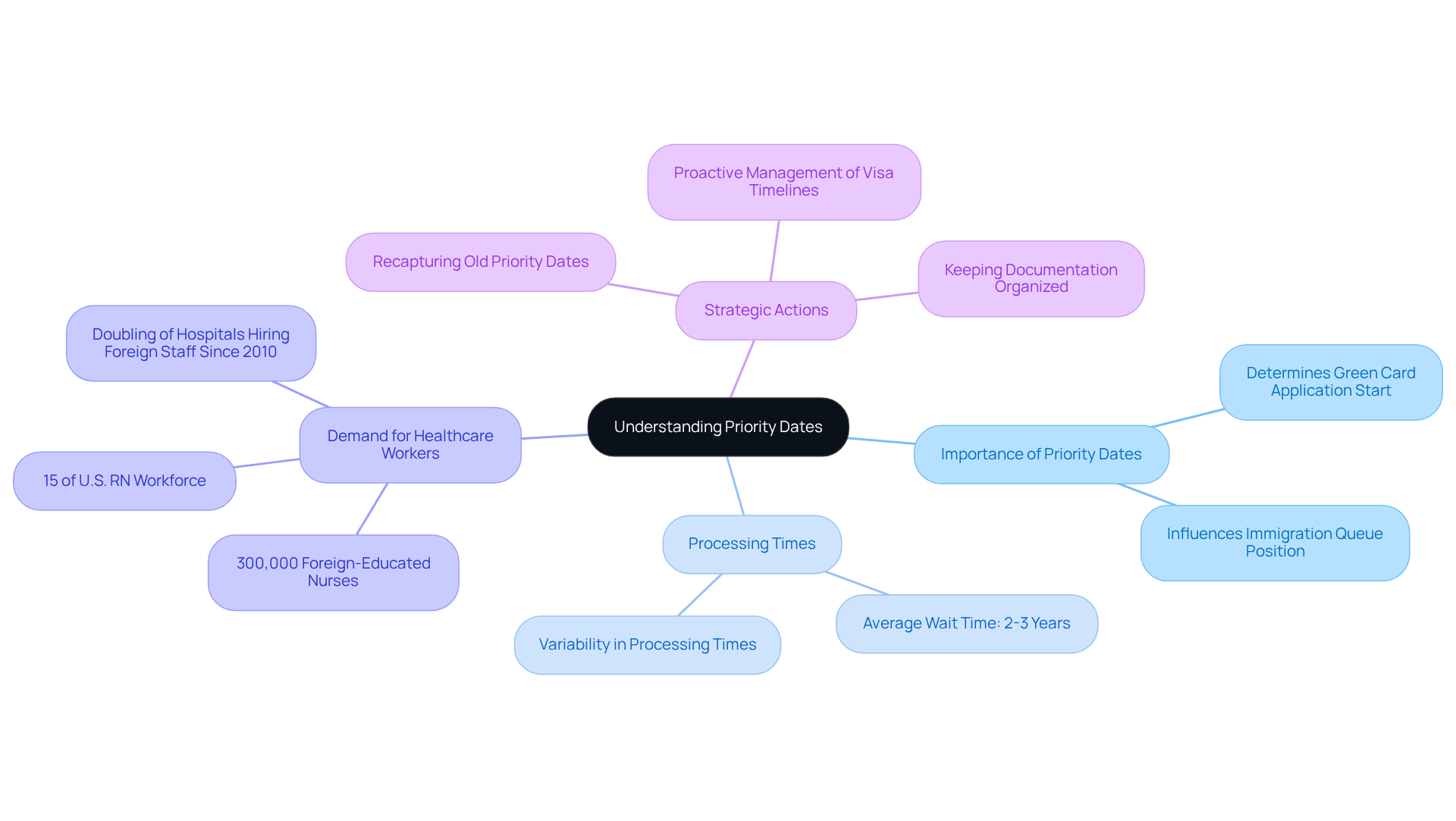
Visa Bulletin Categories: Family-Based vs. Employment-Based Insights
Navigating the immigration visa bulletin can feel overwhelming, particularly in understanding permits. There are two main categories:
- Family-based
- Employment-based
Family-oriented permits are designed for individuals with close relatives who are U.S. citizens or permanent residents. On the other hand, employment-oriented permits cater to those who have job offers from U.S. employers.
For many medical workers, the employment-based categories are crucial. Take the EB-3 category, for instance. It specifically targets skilled workers, including nurses and other medical professionals.
Have you ever felt lost in the immigration process? You’re not alone. We understand how confusing it can be, but you don’t have to face it alone. We’re here to fight for your family and help you navigate these challenges with clarity and compassion.
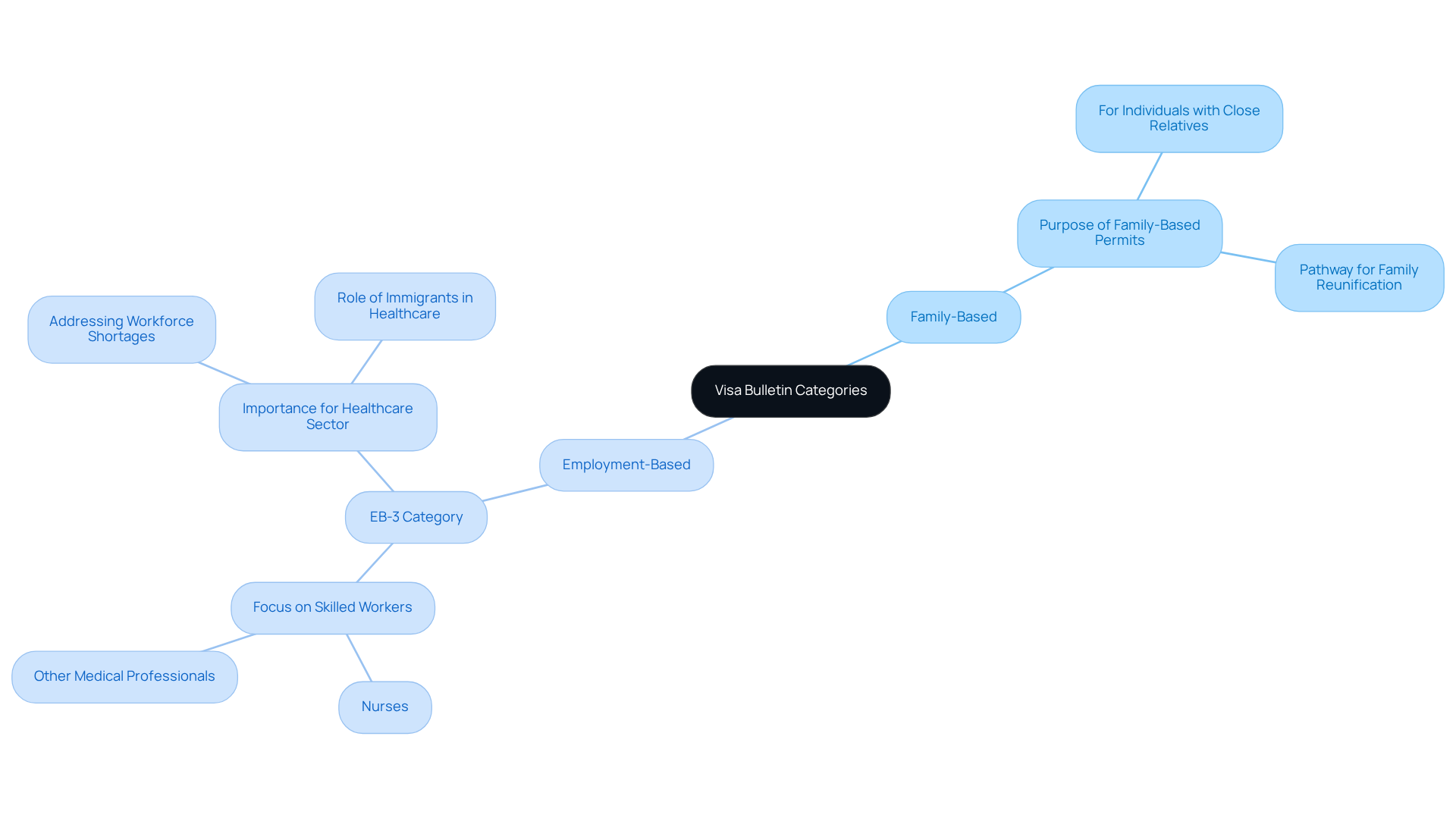
Final Action Dates: What They Mean for Your Visa Application
Final Action Dates are crucial in the application process, determining when a permit can be issued. For medical professionals, understanding these timelines is essential to avoid unnecessary delays. If your priority timestamp is earlier than the Final Action Timestamp listed in the immigration visa bulletin, you may proceed with your application. Immigration attorneys emphasize that knowing these timelines can significantly impact the immigration journey for medical professionals.
Consider the recent decline in EB-3 applications, which has posed challenges for many international nurses and physicians. The State Department's decision to revert the final action date for EB-3 permits to December 1, 2021, has limited new applications, leaving many qualified medical professionals uncertain about their future. This situation highlights the need for proactive monitoring of the immigration visa bulletin, as delays can hinder healthcare facilities' ability to effectively address staffing shortages.
Moreover, the Healthcare Workforce Resilience Act aims to reclaim 25,000 unused green cards for international nurses, potentially alleviating some of the strain caused by the limited supply of permits. With around 40,000 EB-3 permits granted each fiscal year, competition is fierce, making it vital for candidates to stay informed.
Real-life examples illustrate the consequences of these changes. Many medical workers have faced prolonged waiting times due to fluctuating Final Action Dates, disrupting their plans to work in the U.S. For instance, a nurse from the Philippines eagerly awaiting her visa encountered a delay when the cut-off date regressed, postponing her application by several months. Such experiences underscore the importance for medical professionals to remain aware of the immigration visa bulletin and its effects on their residency status.
To stay informed, medical professionals should regularly review the immigration visa bulletin issued by the U.S. Department of State and seek guidance from legal experts regarding their individual circumstances.
In summary, Final Action Dates are not just bureaucratic milestones; they play a pivotal role in shaping the immigration landscape for healthcare workers. Staying informed about these timelines empowers applicants to navigate the complexities of the immigration process more effectively.
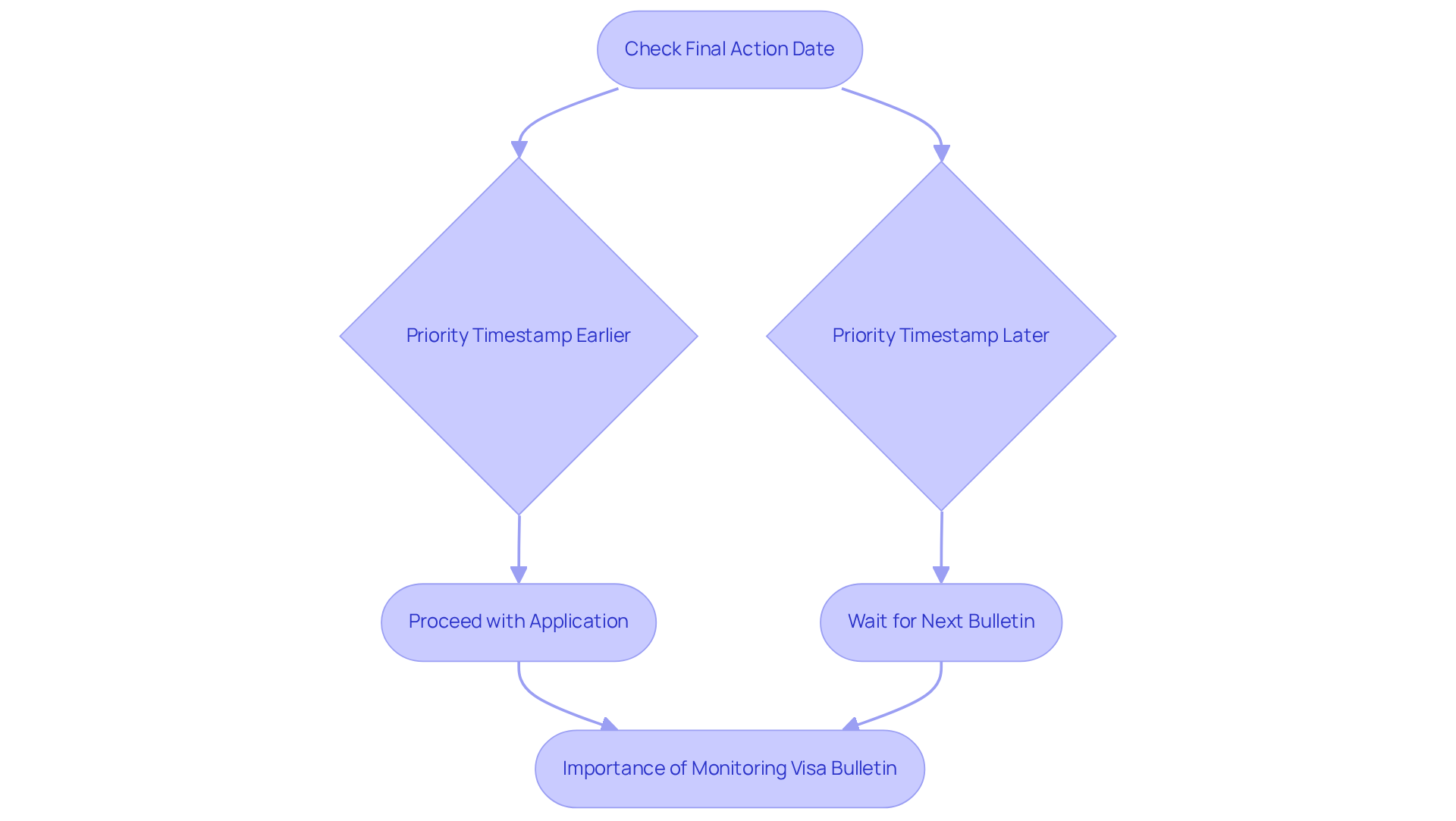
Retrogression Explained: How It Impacts Your Visa Process
Retrogression is a real challenge when the demand for permits outstrips the available supply, pushing priority timelines further back. This situation hits medical professionals hard, leading to frustrating delays in their immigration applications. For example, many nurses are currently facing waiting times that stretch from 5 to 10 years for their EB-3 applications, especially if they hail from high-demand countries like India and China.
So, what can you do? Stay vigilant and keep a close eye on the immigration visa bulletin for updates. The immigration visa bulletin indicates that retrogression can change month to month, directly impacting your ability to file or advance your applications. Immigration lawyers emphasize the need for proactive planning. They recommend that medical professionals get their paperwork organized ahead of time and stay informed about shifts in priority timelines. This way, you can lessen the impact of retrogression on your immigration journey.
By staying on top of these details, you can navigate the complexities of the immigration process more effectively. Be ready to act as soon as your priority dates become current. Remember, you’re not alone in this fight - we’re here to support you every step of the way.
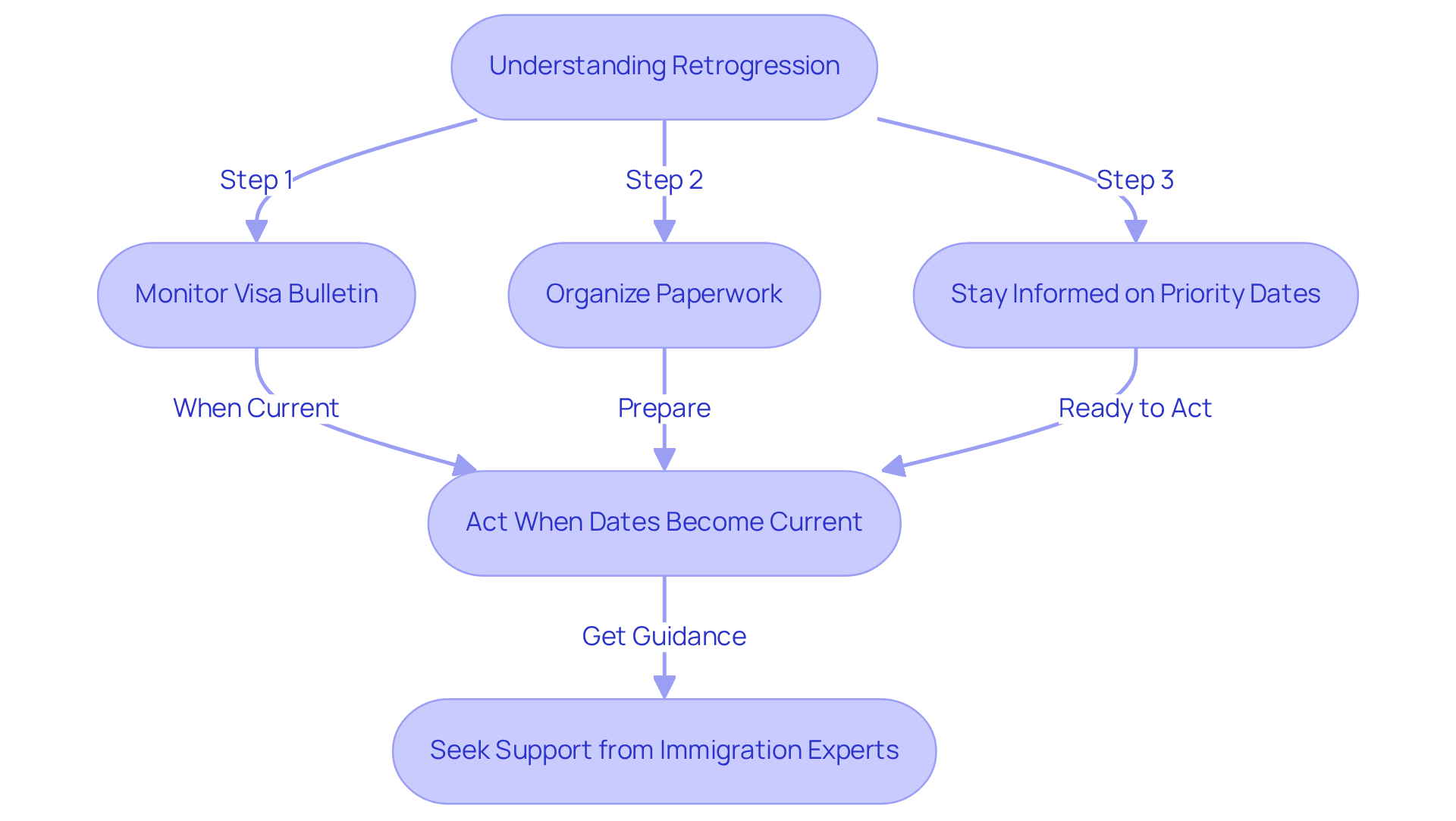
Contingency Planning: Preparing for Changes in Visa Availability
Contingency planning is crucial for healthcare workers facing the complexities of permit availability. Have you ever felt overwhelmed by the immigration visa bulletin and the immigration process? To tackle potential setbacks or delays, it’s vital to have a proactive strategy in place. This means gathering necessary documentation ahead of time - employment verification letters, educational credentials, and any other relevant paperwork that might be needed during the application process. Consulting with an attorney can also offer valuable insights into alternative options tailored to your unique situation.
Immigration attorneys emphasize the importance of being prepared for unexpected changes in the immigration visa bulletin and permit policies. For instance, Monique Kornfeld, an experienced attorney, suggests that keeping a well-organized file of all relevant documents can significantly speed up the process when delays arise. She notes that clients who take the initiative to prepare often experience smoother transitions during changes in their permits.
Moreover, medical professionals should stay updated on the latest news and developments in the immigration visa bulletin that could impact their residency status. Engaging with professional networks and attending immigration seminars can provide critical information and support. Remember, by being proactive and informed, you can better navigate the challenges of immigration delays and ensure you’re ready for any changes that may come your way. We’re here to fight for your family.
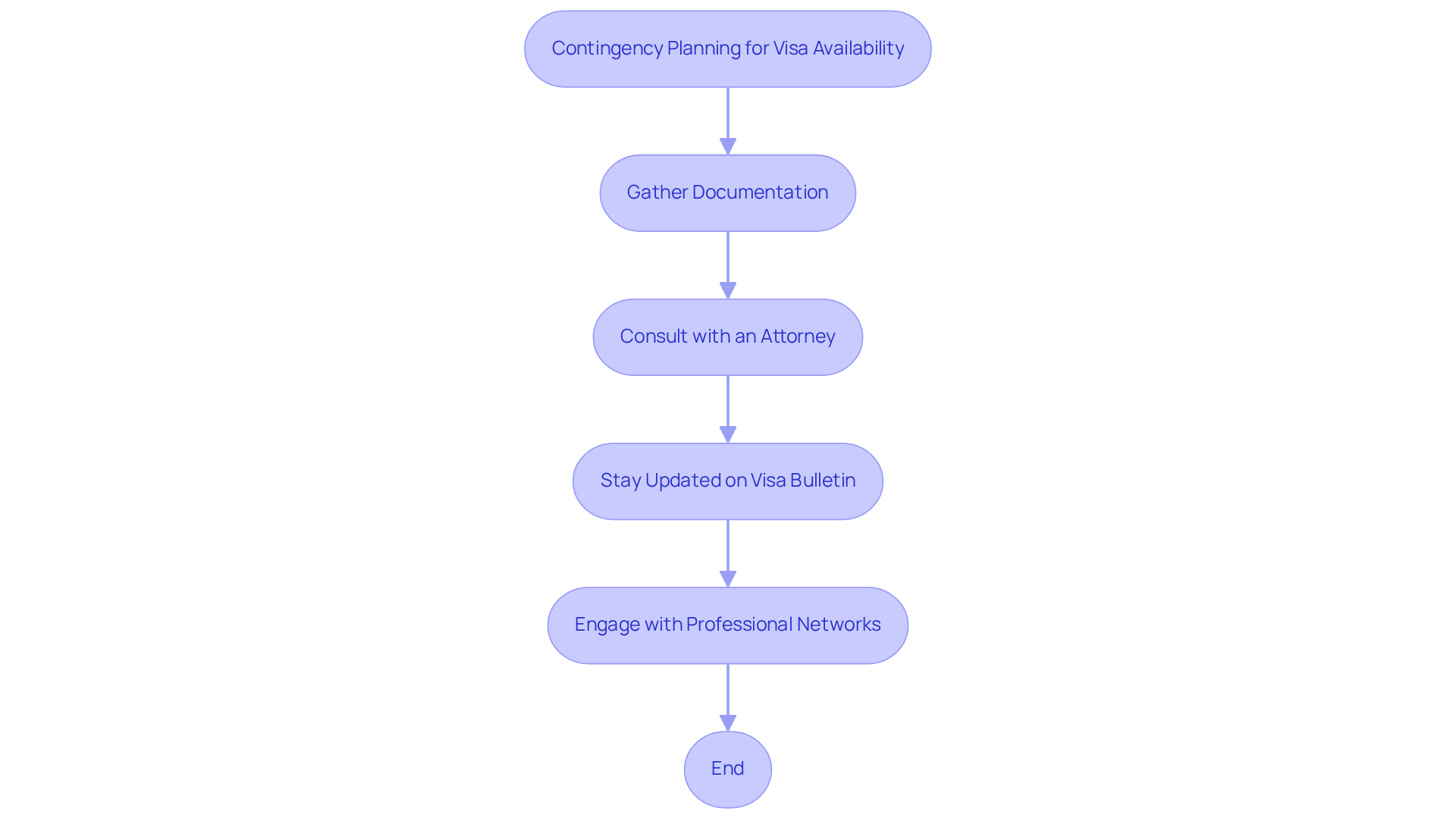
Stakeholder Communication: Keeping Everyone Informed During Your Visa Process
Effective communication with all stakeholders - employers, family members, and legal representatives - is crucial during the application process. Have you ever felt lost in the immigration maze? Regular updates about your application status and any changes in the immigration visa bulletin help keep everyone informed and ready for the next steps. Statistics show that when employers get involved, the success rate of healthcare worker visa applications can jump by up to 30%. Engaged employers provide essential support and documentation, making a real difference.
Implementing structured communication strategies, like scheduled check-ins and transparent sharing of information, fosters trust and collaboration among all parties. We understand how overwhelming this feels. Keeping stakeholders informed not only eases anxiety but also empowers them to help navigate the complexities of the visa process. As immigration attorney Ozan Say noted, "Maintaining open lines of communication is vital for ensuring that all parties are aligned and can respond effectively to any developments."
It’s also important to be aware of potential delays in processing times due to new policies, which can impact everyone involved. Remember, you’re not alone in this fight. We’re here to support you every step of the way.
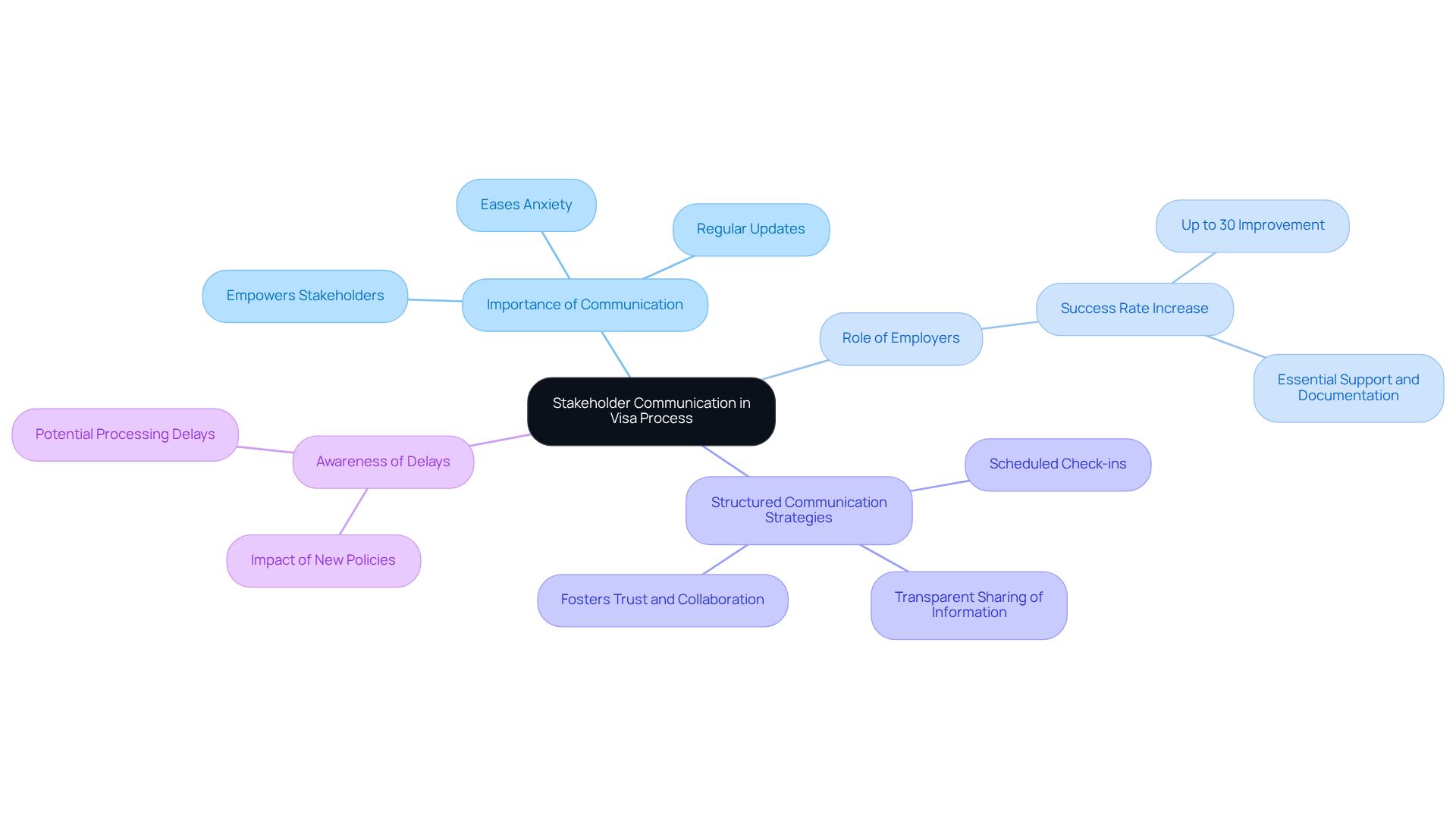
Common Misconceptions: Debunking Myths About the Visa Bulletin
Misunderstandings about the immigration visa bulletin are all too frequent. Many believe that having a current priority date guarantees a quick permit issuance. But the truth is, several factors come into play, like processing times and additional requirements. Even when a priority date is current, applicants can still face delays due to necessary background checks and documentation verification. Statistics show that processing times can vary widely based on visa categories and the applicant's country, with some waiting months or even years.
It’s a misconception that all immigration cases follow a standard process. Each case is unique, shaped by personal circumstances such as family ties, employment status, and humanitarian factors. Legal experts warn that even a small mistake in the application can lead to serious setbacks, including denials or removal proceedings. That’s why it’s crucial for medical professionals to seek guidance to navigate these complexities effectively.
Beyond understanding the immigration visa bulletin, immigrant healthcare workers must also be aware of their rights and the immediate steps to take in legal emergencies, such as receiving a subpoena or facing ICE enforcement. Knowing your rights - like the right to remain silent and the right to an attorney - is vital. If you find yourself in such a situation, remember to exercise your right to remain silent, request an attorney right away, and don’t answer questions without your lawyer present. Reach out to legal professionals who can provide urgent assistance. Your rights and freedom may depend on swift action.
Moreover, many misunderstandings about the immigration visa bulletin lead to confusion regarding priority timelines. Some might think tracking only the Final Action Dates is enough, but it’s essential to grasp the entire bulletin, including availability dates and specific employment-based preference categories. As immigration law evolves, staying informed about the immigration visa bulletin is crucial for anyone looking to secure their immigration status. Additionally, the complexities surrounding chargeability can also affect processing, making a thorough understanding of the immigration visa bulletin even more crucial.
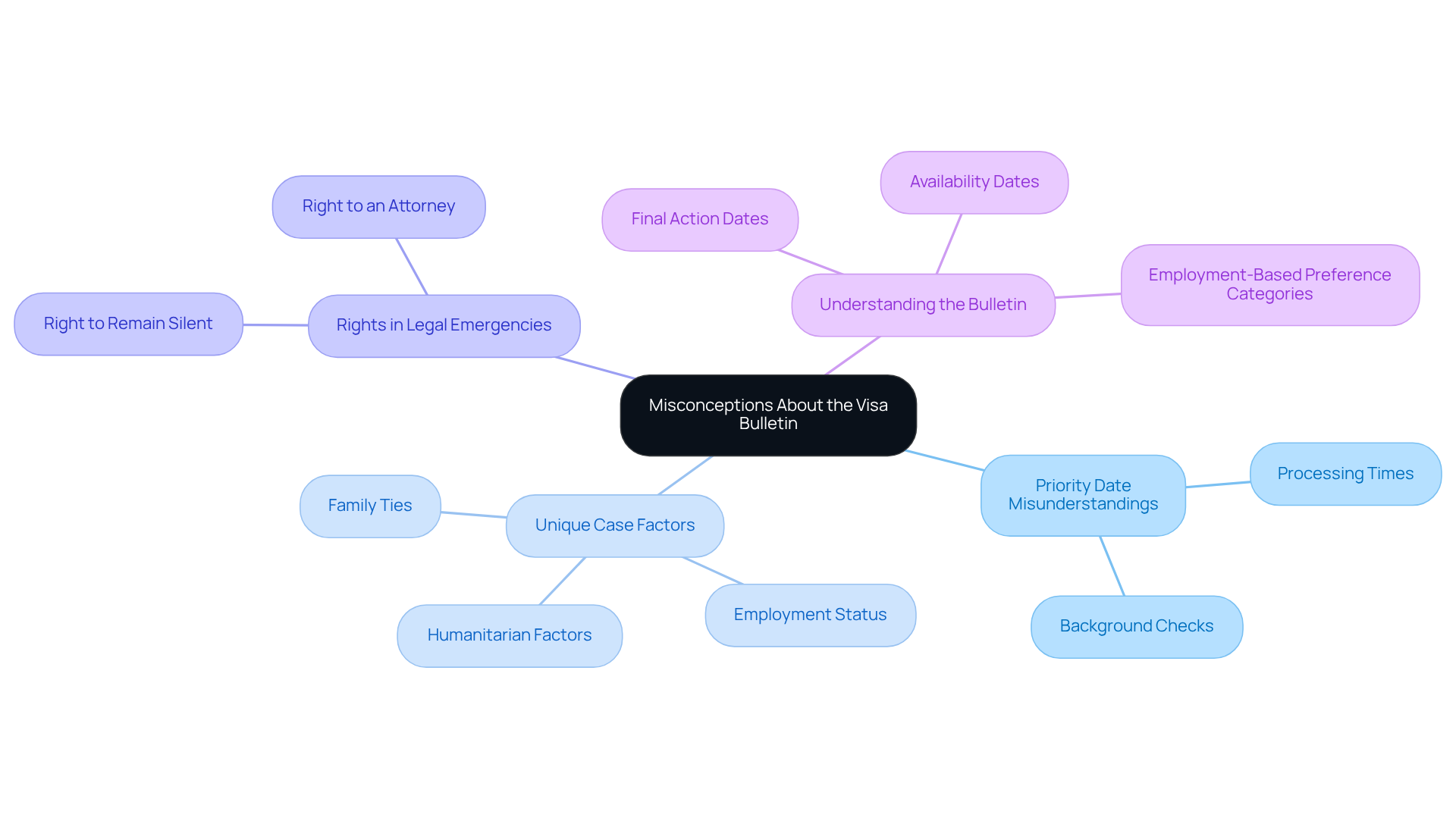
Monthly Updates: Staying Informed with the Latest Visa Bulletin Releases
The immigration visa bulletin is a crucial resource, updated monthly, which provides essential information on availability and priority dates. For medical professionals, regularly reviewing the immigration visa bulletin is essential to staying informed about their application status and any changes that could impact their relocation process. Being in the know not only helps them understand the current landscape of travel permits but also allows them to anticipate potential shifts in their relocation timelines.
Have you ever felt overwhelmed by the immigration process? Specialists recommend setting reminders to check the immigration visa bulletin every month. This simple habit can significantly enhance awareness of any changes that might affect eligibility. Many medical professionals have successfully navigated their relocation journeys by staying proactive and informed through these updates.
On average, the immigration visa bulletin experiences several changes in visa availability each month, which reflects ongoing shifts in immigration policy and demand. The December 2025 immigration visa bulletin indicates steady progress across various family-sponsored and employment-based categories, bringing thousands of applicants closer to green card eligibility. This consistent forward movement is especially relevant for medical professionals, as it can open new avenues to lawful permanent residency. By making the immigration visa bulletin a regular part of their routine, healthcare workers can better position themselves to respond to changes and seize opportunities as they arise.
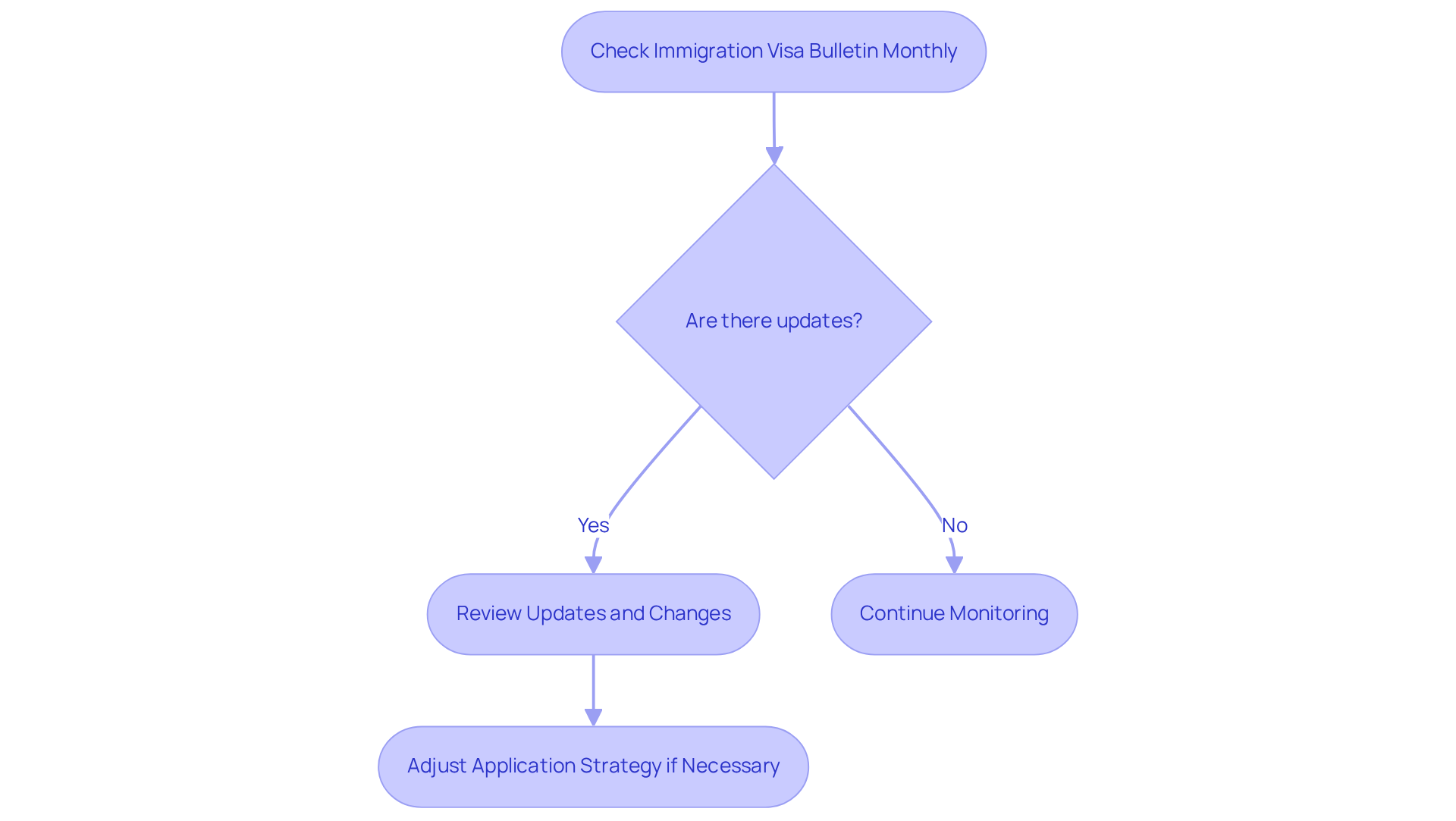
Visa Bulletin FAQs: Answers to Your Most Pressing Questions
Have you ever felt lost in the immigration process? Common questions about the Visa Bulletin often arise:
- What is a priority timestamp?
- How often is the bulletin updated?
- What should you do if your priority date regresses?
A priority timestamp is simply the moment your application is submitted, marking your place in line for a visa. The Visa Bulletin is typically updated every month, reflecting changes in visa availability and priority timelines. If your priority date moves backward, it’s crucial to stay informed and consult a legal expert to explore your options. Remember, you’re not alone in this fight.
Understanding these FAQs can empower healthcare workers to navigate their immigration process more effectively. We’re here to fight for your family and ensure you have the clarity you need in these challenging times.

Conclusion
Navigating the immigration visa bulletin is crucial for healthcare workers eager to build their careers in the United States. This article sheds light on the complexities of the visa process, stressing the importance of grasping priority dates, final action dates, and the differences between family-based and employment-based categories. With insights into retrogression and the necessity for proactive contingency planning, it’s evident that staying informed can significantly shape your immigration journey.
Have you ever felt overwhelmed by the visa process? Key points include:
- The vital role of priority timestamps in determining visa availability
- The urgency of keeping an eye on the immigration visa bulletin for real-time updates
- The need for effective communication among all parties involved in the visa application process
Misunderstandings about the visa bulletin-like the notion that a current priority date guarantees swift processing-have been clarified, underscoring the importance of thorough understanding and preparation.
Ultimately, the message is clear: healthcare workers must actively engage in their immigration journey. Regularly reviewing the visa bulletin, preparing necessary documentation, and seeking expert guidance are essential steps. By doing this, you can navigate the complexities of the immigration landscape more effectively and seize opportunities as they arise. The future may seem daunting, but with the right information and support, achieving residency in the U.S. is within reach. Remember, we’re here to fight for your family and your future matters to us. Yo Peleo - We Fight.
Frequently Asked Questions
What is the role of the immigration visa bulletin for medical professionals?
The immigration visa bulletin is crucial for determining visa availability, particularly for medical professionals like nurses, who typically fall under the EB-3 category.
How does the EB-3 category affect the immigration process for nurses?
The EB-3 category accounts for 28.6% of the global limit, allowing approximately 40,040 immigrants each year. This is significant due to the projected need for an additional 2.9 million nurses by 2030 in the U.S.
What experience does Vasquez Law Firm have in immigration law?
Vasquez Law Firm has over 30 years of experience in immigration law and has successfully assisted thousands of clients, particularly medical professionals.
Why is understanding priority dates important for medical professionals?
Priority dates determine when an immigration request is filed with USCIS and dictate when individuals can start their green card applications. It is essential for tracking progress and knowing when to act.
What are the current processing times for medical visas?
As of November 2025, processing times for medical visas can vary widely, with many applicants facing waits of two to three years or longer before obtaining an interview.
How can nurses expedite their green card process?
Nurses who have submitted I-140 petitions may reclaim their old priority timelines, allowing them to bypass current backlogs and speed up their green card process.
What are the two main categories of immigration permits?
The two main categories are family-based permits, for individuals with close relatives who are U.S. citizens or permanent residents, and employment-based permits, for those with job offers from U.S. employers.
Why is it important for healthcare professionals to stay organized with their documentation?
Being organized and ready to act when priority dates become current is crucial for successfully navigating the immigration process and ensuring timely applications.




